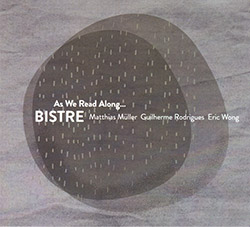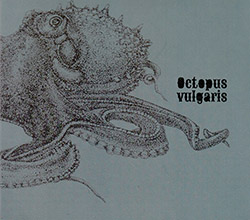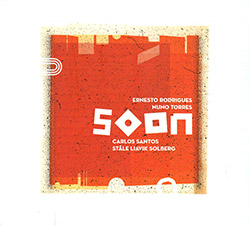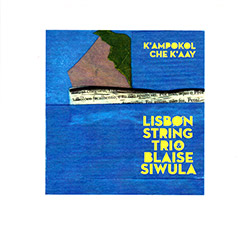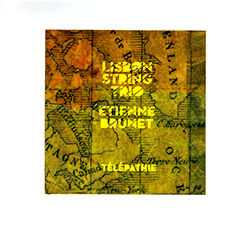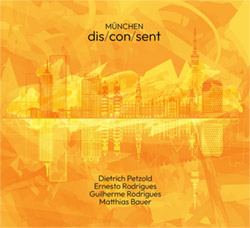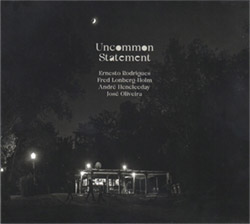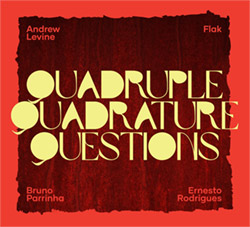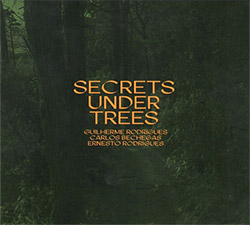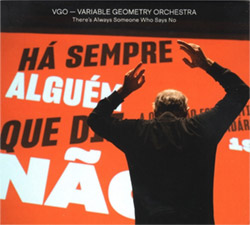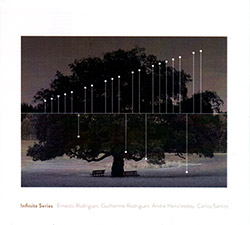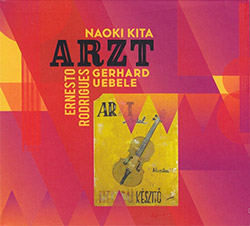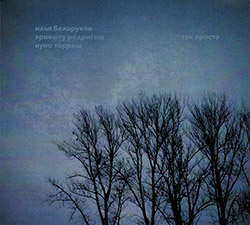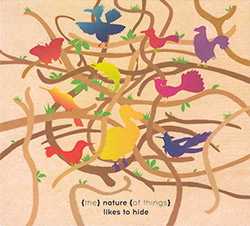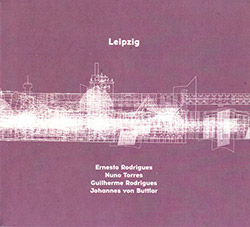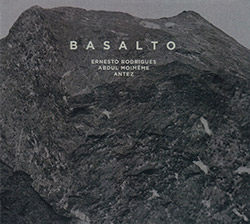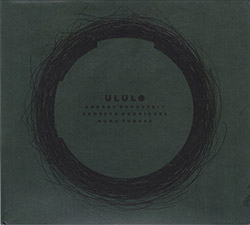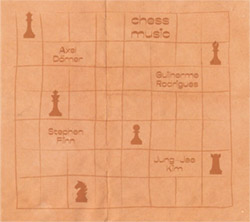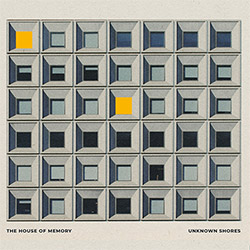![String Theory [PORTUGAL]: Gravity (Creative Sources) String Theory [PORTUGAL]: Gravity (Creative Sources)](https://www.teuthida.com/productImages/misc4/23870.jpg)
A sense of both lightness and weight drawn from Portuguese viola player's Ernesto Rodrigues' 18-piece String Theory, in a large and detailed improvisation using an incredible array of string sources, including viola, harp, violin, cello, viola da gamba, double bass, classical, acoustic and 12-string guitars, mandolin, zither, harpsichord, and piano.
Save $1.60
In Stock
Quantity in Basket: None
Log In to use our Wish List
Shipping Weight: 2.00 units
Sample The Album:
Ernesto Rodrigues-viola, harp
Raquel Fernandes-violin
Maria do Mar-violin
David Maranha-violin
Guilherme Rodrigues-cello
Yu Lin Humm-cello
Helena Espvall-cello
Miguel Ivo Cruz-viola da gamba
Bernardo Alvares-doublebass
Joao Madeira-doublebass
Abdul Moimeme-classical guitar, 12 string acoustic guitar, mandolin
Flak-acoustic guitar
Emidio Buchinho-acoustic guitar
John Klima-acoustic bass guitar
Adriana Sa-zither
Joana Bagulho-harpsichord
Simao Costa-piano
Click an artist name above to see in-stock items for that artist.
UPC: 5609063403619
Label: Creative Sources
Catalog ID: cs361
Squidco Product Code: 23870
Format: CD
Condition: New
Released: 2016
Country: Portugal
Packaging: Cardboard foldover
Recorded live at O'Culto Da Ajuda, on March 11th, 2016, by Miguel Azguime.
"Undoubtedly, one of the most beautiful projects realized by the galaxy of Portuguese improvisers federated around the violist Ernesto Rodrigues and his friends. All the instruments used by the eighteen musicians present are "stringed" whether they are rubbed (violins, violas da gamba, cellos, double basses), plucked (guitars, zither, harps) or hit / plucked by a keyboard mechanism (Piano, harpsichord).
Gravity is a long improvisation that occupies the entire duration of the compact, excellently recorded and prepared for the disc by Ernesto himself. When one imagines the difficulties encountered in finding a decent place, to gather so many musicians, to focus them on a very precise idea like this string orchestra, one can already welcome the extraordinary work of these Portuguese musicians brought together by Ernesto Rodrigues, Which has just produced in 2016 no fewer than eighteen albums with his collaborations. A disc with 18 musicians and 18 Creative Sources albums, four of which present the music of more imposing collective ensembles such as the present String Theory, Theatron, IKB and Variable Geometry Orchestra, the latter two ensembles not having their first try.
The workforce of the Variable Geometry Orchestra in Quasar their new album culminates in 46 musicians. Collectively and musically, it is therefore a work and a long-term work and we can already consider the personality of Ernesto Rodrigues, tireless organizer of Lisbon as unavoidable as those of Eddie Prevost, Rhodri Davies, Michel Doneda or Franz Hautzinger, for example, among the artists who have contributed to the practice of free improvisation over the last twenty years towards minimalist forms, roughly qualifying lower-case, reductionist, new Silence, etc ...
And what is more exemplary than this Gravity which, beginning with a ghostly ostinato, visits the aggregates of sounds, rubbings, pinches, curious vibrations, dynamic squeaks in a kalideoscopic vision and arachneenne of the " Instrumental action. Violoncello or guitar prepared, miasmus of violin, scratching, phantom sounds, mysterious rustles. Although it seems that a forced path is traced, certain instruments intervene in concert as if the moment was chosen: free improvisation and their innate qualities Of mutual listening, of simultaneous action and reaction, and of finesse in empathy, allow String Theory's companions to trace a path, to build a universe that is both homogeneous and heterogeneous according to the point of view square.
Indeed, a community of feeling, an ambient temperature shared by each one is drawn and connects all the specific sounds, timbrales, dynamics, frank affirmations and playful connivances that flush out thirty-nine minutes and thirty five seconds. The actions of the musicians can be very diversified or concentrated in a single impetus according to the feeling of each one. Gravity is a unique recording in the annals of improvised music and that is why I will later discuss the sister projects IKB, Variable Geometry Orchestra and Theatron in the following chronicles. It is not every day that such extensive orchestral formations are documented in the field of contemporary improvisation."-Jean-Michel van Schouwburg, Orynx (translated by Google)
Artist Biographies
• Show Bio for Ernesto Rodrigues "He has been playing the violin for 30 years and in that time has played all genres of music ranging from contemporary music to free jazz and improvised music, live and in the studio. His main interest shifted towards contemporary improvised and composed music. The relationship with his instruments is focused in sonic and textural elements. Electronic music was an early influence on his approach to violin playing, which challenges traditional romantic concepts of the violin/viola through use of preparations and micro tuning. Active in different settings on the Portuguese scene for free improvised music, both as a collaborator and in leading his own groups. Music for Dance, Cinema, Video and Performance. Has created the record label Creative Sources Recordings in 1999, which mainly concentrates on releasing experimental and electro-acoustic music." ^ Hide Bio for Ernesto Rodrigues • Show Bio for Maria do Mar "Maria do Mar, violinist born in Lisbon, has a path marked by classical music and teaching, although she has always collaborated with artists from other musical areas. Since 2012, following her participation in the "Atelier de Improvisation et Direction de Ensemble in real-time (Conduction)" directed by Butch Morris, she began to explore free improvisation and other languages in the contemporary music scene, taking part in a violin and Electric bass duo with the musician and composer Ricardo A. Freitas.She has developed improvisational work with various musicians, performing in concerts, cycles and festivals, with names like Carlos "Zingaro",., Joana Guerra, Ricardo Jacinto, Christophe Berthet, Maria Radich. In the context of the Moving Theater she participated in the Suzuki workshop / Viewpoints by Lowri Jenkins and Jane Pupo. She is seeking a broader musical universe and the development of a personal language, where the musical boundaries are fading and new possibilities opens up with no creative limits." ^ Hide Bio for Maria do Mar • Show Bio for David Maranha "David Maranha is a Portuguese musician known from the experimental/drone project Osso Exótico, which regularly releases albums since the 80s. More recently, David has released some albums under his own name (Marchs Of The New World - 2008, Antarctica - 2010, among others). His albums' reviews and his discography can be found at http://davidmaranha.blogspot.com." ^ Hide Bio for David Maranha • Show Bio for Guilherme Rodrigues "Was born 1988 in Lisboa, Portugal and started playing cello and trumpet at Orquestra Metropolitana de Lisboa at the age of 7. In 1999 joined Conservatório Nacional de Música de Lisboa to study classical and music theory and in the current year recorded his first album - Multiples - with Ernesto Rodrigues and José Oliveira out on Creative Sources Recordings. Apart from work in music ensembles ranging for contemporary classical to free improvisation, also works with live music poetry, theatre and film-music. After lengthy residency in Lisboa, (1988-2016) moved to Berlin and has been active as composer and improviser in the scene. Worked with some international and renewed artists like Ernesto Rodrigues, Jean-luc Guionnet, Margarida Garcia, Manuel Mota, Alfredo Costa Monteiro, Sei Miguel, Tim Goldie, Jeffrey Morgan, Oren Marshall, Gerhard Uebele, Klaus Kurvers, Gabriel Paiuk, Nicolas Field, Jaime Fennelly, Blaise Siwula, Will Guthrie, Pawel Grabowski, Michael Thieke, Wade Matthews, Leonel Kaplan, Diego Chamy, Gabriel Paiuk, Barry Weisblat, Joe Giardullo, Jassem Hindi, Tisha Mukarji, Masahiko Okura, Taku Unami, Toshihiro Koike, Sharif Sehnaoui, Christine Abdelnour, Alexandre Bellenger, Carlos Zingaro, Romaric Sobac, Nuno Rebelo, Nuno Torres, Naoto Yamagashi, Heddy Boubaker, Gerhard Uebele, Guillermo Torres, Tomas Gris, Carlos Santos, Bruno Parrinha, Miguel Leiria Pereira, Miguel Ivo Cruz, Alberto Cirera, Nuno Morão, Mark Sanders, Dennis Gonzaléz, Alípio Carvalho Neto, Raymond Macdonald, Neil Davidson, David Stachenas, Lisa Ullén, D'incise, Cyril Bondy, Miguel Mira, Rodrigo Amado, Abdul Moimême, Monsieur Trinité, João Madeira, Álvaro Rosso, Gil Gonçalves, Marian Yanchyk, Filipe Passos, Rodrigo Pinheiro, Christian Wolfarth, Thanos Chrysakis, Bechir Saade, Kurt Liedwart, Miguel A. Garcia, Ilia Belorukov, Andrew Lafkas, Gao Jiafeng, Eric Wong, Johan Moir, Casey Moir, Magda Mayas, Matthias Muller, Alexander Frangenheim ... Has performed and toured in all Europe. Released more than 30 albums of his own projects." ^ Hide Bio for Guilherme Rodrigues • Show Bio for Yu Lin Humm Cellist Yu Lin Humm is a member of String Theory and Suspensão. She studied music at the Accademia Internazionale della Musica in the field of study of classical music. ^ Hide Bio for Yu Lin Humm • Show Bio for Helena Espvall "Helena Espvall is a cello player who is comfortable in indie rock and improvised music circles. She was born and raised in Sweden, playing guitar and cello in rock bands and a silent movie orchestra. Moving to the U.S. and settling in Philadelphia in 2000, Espvall further explored Arabic music, performed with the Amnesiac Music & Dance Ensemble, and joined the contemporary psychedelic-folk group Espers, recording the CDs Weed Tree and II with them. Her penchant for playing free jazz has resulted in collaborations with guitarist Eugene Chadbourne. She is a featured artist with saxophonist/flutist Oluyemi Thomas on his recording Before the Beginning, and with From Quagmire on Habitats in the Wound. Espvall's debut CD as a leader, Nimis & Arx, from the Pax/Fire Museum label is produced by George Korien, where she plays cello, guitar, and recorder, sings and uses electronics. Other artists she has worked with include Katt Hernandez, Lukas Ligeti, Masaki Batoh, Gui Mallon, Nick Castro, Bert Jansch, Sharron Kraus, Fürsaxa, Vashti Bunyan, Samara Lubelski, Marissa Nadler, Damon & Naomi, Arborea, Curia, Golden Ball, the Valerie Project, Polineros, and Scorces. Helena Espvall is a Swedish-American musician noted for her participation in the post-millennial psych-folk and free improv scenes. Her primary instruments are cello, guitar and voice." ^ Hide Bio for Helena Espvall • Show Bio for Miguel Ivo Cruz Lisbon, Portugal based cellist Miguel Ivo Cruz is a member of the groups String Theory, Variable Geometry Orchestra. He works at the Conservatório Nacional Escola Artística de Música. ^ Hide Bio for Miguel Ivo Cruz • Show Bio for Bernardo Alvares "My name is Bernardo Alvares, I was born in 1989 and I live in Lisboa. I originally came to Lisboa to study. First I took an BSc in African Studies in FLUL (University of Lisbon) while studying jazz doublebass in Hot Clube de Lisboa. Soon I grew tired of conventional jazz and became part of the free improvisation movement. Later I continued my studies with an MSc in Urban Studies in ISCTE-IUL (Lisbon University Institute) and FCSH-UNL (New University of Lisbon) and wrote a master thesis about the relations between precariousness and counterculture in the contemporary city. As a musician I've been developing mostly doublebass and electric bass in languages such as free improvisation, free jazz, rock, noise, drone and hip-hop. I have allready worked with musicians such as Alan Courtis, Carla Bozulich, Helena Espvall, Paulo Raposo, Ernesto Rodrigues, Maresuke Okamoto, McCloud Zicmuse, Roland Ramanan, Mário Babrem, LBC Soldjah, Hezbó MC or Ondness. My most consistent musical projects includes Zarabatana, Alforjs and Luís Severo but I was also been a part of the doublebasses drone duo ABBA, the free-punk band dUASsEMIcOLCHEIASiNVERTIDAS, the Cornelius Cardew inspired anarchist ensemble Tratado de Cardew, the free-improv trio Chaparreiro/Álvares/Morão, the spokenword band Tapete, the William Burroughs inspired noisy duo S for Seward and several other ad-hoc formations. I've also worked with other artists such as Flora Detraz and Elizabete Francisca (dance/performance), Stéphane Blumi (video), Nacho Durán (multimedia), Paula Alonso (actress), Manuel Badás (dancer), Yaw Tembe (plastic arts), or Cristina Delius (tapdancing). I've also made sound instalations for the exhibitions "Partida, Largada, Fugida" from Mariana Marques and "Zones d'habilité" from Aude Barrio and Barbara Meuli. I've gave workshops of improvised music in Portugal, in CACAU (São Tomé, São Tomé e Príncipe) and Paraiso LC (Oviedo, Spain). I've been working with Alan Courtis on a music project with Out.Ra and Associação Nós, an association in Barreiro, Portugal, for the inclusion of people with mental diversity. This group debuted live in March 2016 and continued in 2017, although we're looking for a way to fund it. I curated Leitmotiv, which was a music and publications monthly cycle where musicians interpret graphic scores made purposely for this cycle hosted by Zaratan Gallery. Music related, I'm also a DJ, a producer and occasional sound technician. I've also made regular music critics to jazz.pt magazine between 2013 and 2015 and was part of the associations Pantalassa and Associação Terapêutica do Ruído." ^ Hide Bio for Bernardo Alvares • Show Bio for Joao Madeira Joao Madeira: "I was born in Lisboa and I've dedicated most of my energy to the doublebass since I was 12. When I went to study at the Conservatório de Lisboa my role model was doublebassist João Panta Nunes, and lately my studies were oriented by Jorge Lee, at Cascais. I have a degree in Musicology, investigation work on Fado's candidature to World Immaterial Heritage by UNESCO, and coordination of the Music Department at INATEL/FNAT. Since 1999 I have a strong activity (studio and performance) in several styles and genres, but improvised music and original composition (whatever the style...) are the places where my musical language riches its higher satisfaction and plenitude. In the recordings you are about to hear it's me who plays all the instruments. My passion is at the simple act of artistic creation. For me, music is all about musicians and genuine expression! It doesn't matter the genre neither the instrument per si. In theater I have collaborations (musician, composer, actor) with Companhia do Chapitô and Artistas Unidos, amongst others. I also love books (...) I've studied aesthetics and Portuguese literature since I remember, and love to read and write poetry." ^ Hide Bio for Joao Madeira • Show Bio for Abdul Moimeme "Abdul Moimême was born in Lisbon, in 1959, moving at an early age to New Mexico and later to Dublin, Ireland. He began studying the guitar at the age of 11, studying under various private teachers, in Madrid, Spain. In 1979 he moved to Boston to study architecture, finally completing his degree at the University of Lisbon. In the 90's he began studying the tenor saxophone with Patrick Brennan. In this period he became actively involved with Lisbon's improvised and alternative rock scenes, performing frequently with the Variable Geometry Orchestra since it's creation in 2003, as well as with various other local projects. His main musical partners are from Lisbon and Porto, but he has also performed in public concerts with such artists as Gale Brand, George Haslam, Jon Raskin, Ken Filiano, Patrick Brennan, Steve Adams, and Wade Matthews. In 1999 he started writing about jazz in various Portuguese publications and is currently a permanent collaborator of Jazz.pt magazine, and Publico newspaper, as a critic. In 2006 he created Freemusic (http://freemusic.podomatic.com), a space exclusively dedicated to the promotion of Portuguese improvised music." ^ Hide Bio for Abdul Moimeme • Show Bio for Flak Flak is an improvising and rock guitarist, best known for the Portuguese rock band Rádio Macau.-Squidco 4/17/2024 ^ Hide Bio for Flak • Show Bio for Emidio Buchinho "Born in 1963, in Luanda, Angola. There, in the seventies, heard rock and local ethnic music in between radio sounds from my father's electricity and radio workshop. Saw a lot of films at open-air cinemas. With the independence of the Portuguese colonies moved to Setúbal.At age 15 commenced as a self-taught guitarist. In 1982 formed an experimental music project with Vitor Joaquim. Attended Classical Guitar and Music courses in the Luísa Todi Music and Fine Arts Academy (Setúbal, Portugal) and studied in the Château-Thierry Municipal Conservatory (France). Member of the choirs of both cities. Has a degree in Cinema and Sound Engineering at the Lisbon Film and Theatre School (ESTC - Escola Superior de Teatro e Cinema). Has the Title of Specialist on Sound for Audiovisual and Multimedia, awarded by the Instituto Politécnico de Tomar. Took part in various workshops and courses on Structures, Forms and New Technologies in Improvised Music, supervised by Carlos "Zingaro", Peter Kowald and Richard Teitelbaum; Music and Sound Design for Film, Video and Games, supervised by Bruce Pennycook; Orchestra of Loudspeakers - Sound Spacialization, directed by Miguel Azguime; Initiation to Real Time Sound Programming and Manipulation in Max/MSP Environment, teached by Isabel Pires. Assistant to the composer and musician Carlos "Zingaro" between 1997 and 2000. Participated in concerts and intermedia performances with the likes of Carlos "Zíngaro", Günter Müller, Carlos Santos, Otomo Yoshihide, Nuno Morão, Rudiger Carl, Vitor Joaquim, Ulrich Mitzlaff, Matt Wand, Ernesto Rodrigues, Nuno Rebelo, Mike Beck, Miguel Cabral, Erik M, António Chaparreiro, Phill Niblock, João Silva, Ricardo Guerreiro, Renato Chiunfrini, Pedro Lopes, Pedro Alçada, José Oliveira, Adriana Sá, Ben Rubin, Ludger Lamers, Isabelle Schad, Olga Roriz, Margarida Bettencourt and João Natividade, among others. Works on a regular basis in the areas of musical composition, performance and production, sound engineering, editing and design for films, documentaries, art installations, stage plays, dance, performance art, intermedia and television advertising in Portugal, Spain, France, Germany and the UK. Collaborations include Jorge Silva Melo, Pedro Sena Nunes, Fernando Matos Silva, Luís Fonseca, Fernando Lopes, José Barahona, João César Monteiro, Paulo Rocha, Sandro Aguilar, Walter Avancinni, Rita Palma, Jeremy Cooper, Margarita Ledo Andion, Paulo Mendes, Julião Sarmento, João Onofre, Susana Soares Pinto, Anabela Costa, Maria Joana Fernandes, Cláudia Bandeira, Antonino Solmer, Fernanda Lapa, Diamantino Ferreira, John Clease, Marco Martins, Miguel Coimbra, Gideon Nell, Edson Ataíde, Keith Rowe, Gush, Roof, Silvia Barrios, Greg Moore, Carlos Bica, Bernardo Devlin, Coty Cream, Osso Exótico, Michael Gira, Current Ninety Three, Antony, Simon Finn, Baby Dee, Six Organs of Admittance, Artistas Unidos, Karnart, Cão Solteiro, Teatro Meridional, Teatro da Cornucópia and Teatro da Comuna. He is teacher on Sound Techniques and Technologies for Cinema, Audiovisual and Multimedia at the ESTC-IPL - Escola Superior de Teatro e Cinema, ESCS-IPL - Escola Superior de Comunicação Social, and ESTA-IPT - Escola Superior de Tecnologia de Abrantes. As a Musicain, Sound Designer, Editor and Engineer for Cinema and Audiovisual, taught lessons at ETIC - Escola Técnica de Imagem e Comunicação, RESTART - Instituto de Criatividade, Artes e Novas Tecnologias, Videoteca Municipal de Lisboa, Granular - Associação, Encontros de Viana, Festival de Curtas-Metragens de Vila do Conde, IPA - Instituto Superior Autónomo de Estudos Politécnicos, ESAD-CR-IPL - Escola Superior de Artes e Design, AR.CO - Escola de Artes, including workshops and conferences. Head of the Sound and Music Department at ETIC - Escola Técnica e Imagem e Comunicação, between 2006 and 2010. Director and founding member of the GRANULAR Association, between 2002 and 2016. PhD Student in Science and Art Technology - Computer Music, in the UCP - Universidade Católica do Porto, with the advising of the composer Dr. António de Sousa Dias." ^ Hide Bio for Emidio Buchinho • Show Bio for John Klima "John Klima employs a variety of technologies to produce artwork with hand-built electronics, and computer hardware and software. Consistently connecting the virtual to the real, Klima builds large scale electro-mechanical installations driven by 3D game software he programs from scratch. The virtual computer imagery mirrors and extends the potential and agency of the physical components to produce cohesive worlds that are both humorous and sinister. In 2003 he focused on his long-time fascination with model railroading to create his first HO scale railroad piece, titled simply Train. Exhibited in December 2003 at Postmasters Gallery in New York, Train was shown in April 2005 at the DeCordova Museum in Boston, and in September became part of the permanent collection of the Museo Extremeño e Iberoamericano de Arte Contemporáneo in Badajoz, Spain. Klima has exhibited extensively in museums and galleries in the United States, Europe, and Asia. His exhibitions include BitStreams at the Whitney Museum of American Art as well as the 2002 Whitney Biennial. He has also exhibited at Eyebeam, The New Museum of Contemporary Art, PS.1 and The Brooklyn Museum of Art. His international exhibitions include The Museum for Communication in Bern, Switzerland, the NTT InterCommunication Center in Tokyo, Japan, The Daejeon Municipal Museum in Korea, and numerous international festivals. Selections from his bibliography include the New York Times, The New Yorker, Art Forum, Flash Art, and Business Week. Klima was recently a research scientist at the Courant Institute, New York University, and is currently adjunct Professor of Digital Media at the Rhode Island School of Design. Klima also teaches an extensive course in game design theory and production at the Polytechnic University of Brooklyn. John Klima is represented by Postmasters in New York, Bank Gallery in Los Angeles, and Gallery of International Media Art, Berlin, Germany." Click here to see John Klima's CV.-CityArts.com (http://www.cityarts.com/bio.html) ^ Hide Bio for John Klima • Show Bio for Adriana Sa "Adriana Sá is transdisciplinary artist, performer musician/ composer. Her graphical scores choreograph texture, density, dominance and sequence variations rather than clock-time or note arrangements. Designing and building the instrumentation is part of her creative process. For almost two decades, Sá used sensor technologies to explore music connected to light, space, movement, architecture, weather and social context; her architecturally-scaled instruments combined analogue and digital components. Currently, Adriana develops research about audio-visual instrument design and composition. She has been clarifying artistic insights with the aid of cognition/ attention research, and developing 3D audio-visual software that operates based on pitch detection from a custom zither input. Adriana Sá has been developing and presenting her work around Europe, USA and Japan since 1997. She has consistently developed a number of project-series dedicated to specific artistic investigations: 'Sensations Laboratories', 'Interchange Formats', 'This Is Just To Do', 'Parallax', 'Metaparallax', 'Portablellax', 'Moment In Movement', 'Thresholds', 'Windowmatter' and 'Emotional Object'. In these and other contexts, she has collaborated with hundreds of artists. Currently she is developing two parallel projects: 'Included Middle', with John Klima, and 'Timespine', with John Klima and To Trips. Throughout the years, Adriana work has been presented worldwide, in venues like Calouste Gulbenkian Foundation, Culturgest, Serralves, Teatro Maria Matos or Museu do Chiado in Portugal; Experimental Intermedia Foundation, PS1/ MoMa or Eyebeam in the US; Caixa Forum or Arteleku in Spain; ICA - Institute of Contemporary Arts, The Media Centre Huddersfield or Sonic Arts Research Centre in the UK; and ACAC - Aomori Contemporary Art Center in Japan. She also presented site-specific work in a codfish-drying factory or a chapel, in Portugal, or an active a textile mill in the UK. She performed and exhibited in festivals such as LEM (Spain), Ultrasound (UK), Atlantic Waves (UK), Luzboa Biannual (Portugal), xxxxx (UK), Sonorities (Irland), NIME - New Interfaces for Musical Expression (US) or Version Beta (Switzerland). Adriana´s artistic work has been made possible through grants, funding supports and commissions, by institutions such as Calouste Gulbenkian Foundation (PT), Cultural Ministry (PT), Serralves (PT), Aomori Contemporary Art Centre (JP), Kirkless Media Center Huddersfield (UK), T-U-B-E (GR), European CoDaCo Fund (EU), FLAD- Portuguese-American Foundation (US/PT), Kampnagel (GR) and Instituto Camões (PT). Adriana's artistic practice fluidly expanded her early education in music (Mendelsohn Hochshule fuer Musik. Leipzig, GDR), visual arts (Atelier Livre, António Arroio School, Fine Arts University, Lisbon, PT) and hypermedia design (Teacher Formation Course in Graphic Design for Hypermedia Systems, CNS, Lisbon). Her practice has been furthered with workshops (e.g. at AA- Architechtural Association (UK) or FEUP - Engineering Faculty/ Porto University (PT), communications, texts and audio-CDs. She had a positon as assistent professor at ESAD / Polytechnic Institute Leiria (PT), from 2009 to 2011. In 2011- 16 she was a researcher at Goldsmiths University of London, EAVI research group, Department of Arts and Computing (UK), with a grant by FCT-Foundation for Science and Technology. She is currently a professor at Coimbra University, in the departments of Computing and Arquitecture. Her scientific articles have been published with ICLI 2012, Leonardo Almanac, Leonardo Transactions, XCoAX 2014 and 2017, NIME 2014, and Journal Of Science And Technology Of The Arts." ^ Hide Bio for Adriana Sa • Show Bio for Joana Bagulho Joana Bagulho is a Portuguese harpsichordist, born 1968 in Lisbon. She is a member of String Theory. ^ Hide Bio for Joana Bagulho • Show Bio for Simao Costa "Simão Costa was born in 1979. He lives and works in Lisbon as a musician, composer and pianist. His work links objects / instruments and electronics / code, materializing sound pieces that involve multiple media and forms (concerts, installations, cross disciplinary). Since 2004 he works solo and in collaboration with musicians, visual artists, performers. He also designs and implements educational projects that relate technology and creativity. His work was presented in Portugal, Spain, France, Poland and Holland." ^ Hide Bio for Simao Costa
4/17/2024
Have a better biography or biography source? Please Contact Us so that we can update this biography.
4/17/2024
Have a better biography or biography source? Please Contact Us so that we can update this biography.
4/17/2024
Have a better biography or biography source? Please Contact Us so that we can update this biography.
4/17/2024
Have a better biography or biography source? Please Contact Us so that we can update this biography.
Have a better biography or biography source? Please Contact Us so that we can update this biography.
4/17/2024
Have a better biography or biography source? Please Contact Us so that we can update this biography.
Have a better biography or biography source? Please Contact Us so that we can update this biography.
4/17/2024
Have a better biography or biography source? Please Contact Us so that we can update this biography.
4/17/2024
Have a better biography or biography source? Please Contact Us so that we can update this biography.
4/17/2024
Have a better biography or biography source? Please Contact Us so that we can update this biography.
Have a better biography or biography source? Please Contact Us so that we can update this biography.
4/17/2024
Have a better biography or biography source? Please Contact Us so that we can update this biography.
4/17/2024
Have a better biography or biography source? Please Contact Us so that we can update this biography.
4/17/2024
Have a better biography or biography source? Please Contact Us so that we can update this biography.
Have a better biography or biography source? Please Contact Us so that we can update this biography.
4/17/2024
Have a better biography or biography source? Please Contact Us so that we can update this biography.
Track Listing:
1. Gravity 39:36
Creative Sources
Improvised Music
Free Improvisation
European Improvisation and Experimental Forms
Large Ensembles
Stringed Instruments
Search for other titles on the label:
Creative Sources.
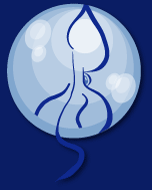

![String Theory [PORTUGAL]: Gravity (Creative Sources) String Theory [PORTUGAL]: Gravity (Creative Sources)](https://www.teuthida.com/productImages/full/23870.Full.jpg)
